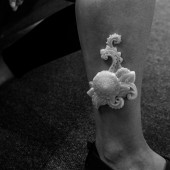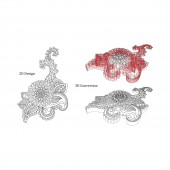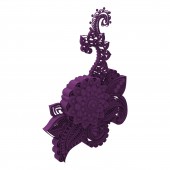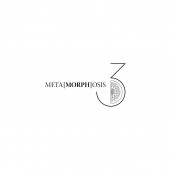Metamorphosis 3D Bespoke Body Modification by Jullien Nikolov |
Home > Winners > #50620 |
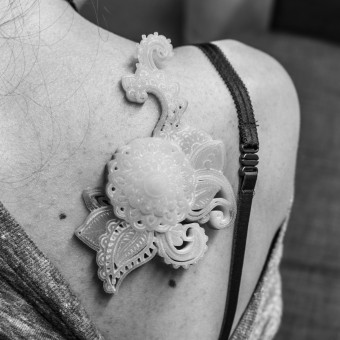 |
|
||||
| DESIGN DETAILS | |||||
| DESIGN NAME: Metamorphosis 3D PRIMARY FUNCTION: Bespoke Body Modification INSPIRATION: As the adoption of tattoos gets more and more mainstream the risk of losing their identity of unique body modifications increases. Moreover, the process of conventional tattooing requires a significant pain tolerance on behalf of the individual being decorated and results in flat designs which merely engage our visual sense. UNIQUE PROPERTIES / PROJECT DESCRIPTION: Project Metamorphosis explores the feasibility of using 3D printing technology to develop a tattoo design which is not only used for decorative purposes, but engages the tactile sense as well. The concept of a three-dimensional tattoo is based on the possibility to transform or "grow" any 2D design into a 3D object using computer software. The resulting end product communicates information about its design through both visual and tactile stimulation. By exploiting this feature, 3D printed tattoos could allow visually impaired people to experience such enhanced decorations in a tactile format. OPERATION / FLOW / INTERACTION: Due to the less permanent and non-invasive nature of such body modifications, 3D printed tattoos can be worn at one's convenience. This is particularly important to those who experience workplace hardship or have difficulty securing a job due to their permanently tattooed or modified in other ways bodies. These are also a relevant alternative for people who are apprehensive of the overall tattooing experience or unwilling to commit to a long-term body modification. PROJECT DURATION AND LOCATION: (Academic Year: 2015-2016) University of Lincoln, Lincolnshire, United Kingdom |
PRODUCTION / REALIZATION TECHNOLOGY: For this project "Selective Laser Sintering" (SLS) technology was used in conjunction with powdered elastomers to create a flexible 3D object which can be applied to the surface of skin using bio-friendly and silicon based adhesives from the make-up industry. SPECIFICATIONS / TECHNICAL PROPERTIES: Dimensions - X: 78.48 mm, Y: 117.5 mm, Z: 15.78 mm Material Volume - 24.6013 cm3; Machine Space - 50.8471 cm3; Surface Area - 311.6159 cm2 TAGS: 3D Tattoos, Metamorphosis 3D, Bespoke Body Modification, 3D Printing, Couture Accessories, Body Art Innovation, Sensory Decoration, Self-expression RESEARCH ABSTRACT: Humans are considered the only creatures which voluntarily choose to alter their appearance. According to some, there is no "right" or "wrong" in how we look as our understanding of "normal appearance" is driven by the age we live in, society and our surroundings. Fashion styles continuously gain and lose popularity which results in ever changing ways of manipulation and modification of the human form (Randall, 1996). Tattooing in this sense is just one of the many ways to satisfy our urge for personal customization and transformation. CHALLENGE: By far the greatest challenge in developing this concept was the use of flexible materials for 3D printing. Moreover, the limited access to industrial additive manufacturing equipment and the relatively low printing resolution of university 3D printers resulted in the production of a basic prototype which physically communicates the concept, but is far from perfect. Further investigation into bio-compatible and highly flexible materials for 3D printing as well as printing resolution of different 3D printing technologies is ongoing. ADDED DATE: 2016-09-24 10:28:24 TEAM MEMBERS (1) : IMAGE CREDITS: Image #1: Photographer Jullien Nikolov, Model Melina Petkovic, 2016. Image #2: Photographer Jullien Nikolov, Model Melina Petkovic, 2016. Image #3: Photographer Jullien Nikolov, Model Melina Petkovic, 2016. Image #4: Designer Jullien Nikolov, Digital Transformation, 2016. Image #5: Designer Jullien Nikolov, 3D Design Model, 2016. |
||||
| Visit the following page to learn more: http://www.artsthread.com/portfolios/met |
|||||
| AWARD DETAILS | |
 |
Metamorphosis 3d Bespoke Body Modification by Jullien Nikolov is Winner in 3D Printed Forms and Products Design Category, 2016 - 2017.· Press Members: Login or Register to request an exclusive interview with Jullien Nikolov. · Click here to register inorder to view the profile and other works by Jullien Nikolov. |
| SOCIAL |
| + Add to Likes / Favorites | Send to My Email | Comment | Testimonials | View Press-Release | Press Kit | Translations |


